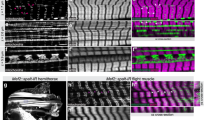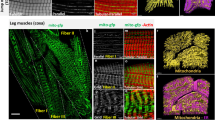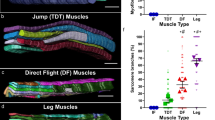Abstract
Myosin is the molecular motor that powers muscle contraction as a result of conformational changes during its mechanochemical cycle. We demonstrate that the converter, a compact structural domain that differs in sequence between Drosophila melanogaster myosin isoforms, dramatically influences the kinetic properties of myosin and muscle fibres. Transgenic replacement of the converter in the fast indirect flight muscle with the converter from an embryonic muscle slowed muscle kinetics, forcing a compensatory reduction in wing beat frequency to sustain flight. Conversely, replacing the embryonic converter with the flight muscle converter sped up muscle kinetics and increased maximum power twofold, compared to flight muscles expressing the embryonic myosin isoform. The substitutions also dramatically influenced in vitro actin sliding velocity, suggesting that the converter modulates a rate-limiting step preceding cross-bridge detachment. Our integrative analysis demonstrates that isoform-specific differences in the myosin converter allow different muscle types to meet their specific locomotion demands.



Similar content being viewed by others
References
Murphy, C. T. & Spudich, J. A. J. Muscle Res. Cell Motil. 21, 139–151 (2000).
Bernstein, S. I. & Milligan, R. A. J. Mol. Biol. 271, 1–6 (1997).
Swank, D. M., Wells, L., Kronert, W. A., Morrill, G. E. & Bernstein, S. I. Microsc. Res. Tech. 50, 430–442 (2000).
Lu, B. D., Allen, D. L., Leinwand, L. A. & Lyons, G. E. Dev. Biol. 216, 312–326 (1999).
George, E. L., Ober, M. B. & Emerson, C. P. Jr Mol. Cell. Biol. 9, 2957–2974 (1989).
Holmes, K. C. Curr. Biol. 7, R112–R118 (1997).
Dominguez, R., Freyzon, Y., Trybus, K. M. & Cohen, C. Cell 94, 559–571 (1998).
Rayment, I., Holden, H. M., Sellers, J. R., Fananapazir, L. & Epstein, N. D. Proc. Natl Acad. Sci. USA 92, 3864–3868 (1995).
Wells, L., Edwards, K. A. & Bernstein, S. I. EMBO J. 15, 4454–4459 (1996).
Swank, D. M. et al. J. Biol. Chem. 276, 15117–15124 (2001).
Collier, V. L., Kronert, W. A., O'Donnell, P. T., Edwards, K. A. & Bernstein, S. I. Genes Dev. 4, 885–895 (1990).
Bagshaw, C. R. Muscle Contraction (Chapman and Hall, London, 1993).
Josephson, R. K., Malamud, J. G. & Stokes, D. R. J. Exp. Biol. 203, 2713–2722 (2000).
Molloy, J. E., Kyrtatas, V., Sparrow, J. C. & White, D. C. S. Nature 328, 429–451 (1987).
Brenner, B. Proc. Natl Acad. Sci. USA 85, 3265–3269 (1988).
Regnier, M., Martyn, D. A. & Chase, P. B. Biophys. J. 71, 2786–2794 (1996).
Huxley, A. F. Prog. Biophys. 7, 255–318 (1957).
Spudich, J. A. Nature 372, 515–518 (1994).
Rome, L. C. et al. Proc. Natl Acad. Sci. USA 96, 5826–5831 (1999).
Houdusse, A. & Sweeney, H. L. Curr. Opin. Struct. Biol. 11, 182–194 (2001).
Geeves, M. A., Perreault-Micale, C. & Coluccio, L. M. J. Biol. Chem. 275, 21624–21630 (2000).
Rosenfeld, S. S. et al. J. Biol. Chem. 275, 25418–25426 (2000).
Dickinson, M. H. et al. Biophys. J. 73, 3122–3134 (1997).
Lehmann, F. O. & Dickinson, M. H. J. Exp. Biol. 200, 1133–1143 (1997).
Curtsinger, J. W. & Laurie-Ahlberg, C. C. Genetics 98, 549–564 (1981).
Cripps, R. M. et al. J. Cell Biol. 126, 689–699 (1994).
Reedy, M. C. & Beall, C. Dev. Biol. 160, 443–465 (1993).
Hyatt, C. J. & Maughan, D. W. Biophys. J. 67, 1149–1154 (1994).
Drummond, D. R., Hennessey, E. S. & Sparrow, J. C. Mol. Gen. Genet. 226, 70–80 (1991).
Rayment, I. et al. Science 261, 50–58 (1993).
Huxley, A. F. & Simmons, R. M. Cold Spring Harb. Symp. Quant. Biol. 37, 669–680 (1973).
Acknowledgements
We thank R. Milligan for the myosin S1 structure shown in Fig. 1, D. Warshaw, S. Lowey, K. Trybus, J. Moore and K. Littlefield for helpful discussions, and W. Barnes, W. Kronert and G. Manipon for technical assistance. We also appreciate the valuable suggestions of an anonymous reviewer. This work was supported by research grants from the National Institutes of Health (NIH) to S.I.B. (GM 32443) and D.W.M., by NIH Minority Biomedical Research Support fund (GM 58906) to F.S. and by postdoctoral fellowships to D.M.S. from the NIH and the American Heart Association, Western States Affiliate.
Author information
Authors and Affiliations
Corresponding author
Ethics declarations
Competing interests
The authors declare no competing financial interests.
Rights and permissions
About this article
Cite this article
Swank, D., Knowles, A., Suggs, J. et al. The myosin converter domain modulates muscle performance. Nat Cell Biol 4, 312–317 (2002). https://doi.org/10.1038/ncb776
Received:
Revised:
Accepted:
Published:
Issue Date:
DOI: https://doi.org/10.1038/ncb776
- Springer Nature Limited
This article is cited by
-
Bridging two insect flight modes in evolution, physiology and robophysics
Nature (2023)
-
Drosophila myosin mutants model the disparate severity of type 1 and type 2B distal arthrogryposis and indicate an enhanced actin affinity mechanism
Skeletal Muscle (2020)
-
The roles of troponin C isoforms in the mechanical function of Drosophila indirect flight muscle
Journal of Muscle Research and Cell Motility (2014)
-
Conformational changes at the nucleotide site in the presence of bound ADP do not set the velocity of fast Drosophila myosins
Journal of Muscle Research and Cell Motility (2013)
-
Comparative genomic analysis of the arthropod muscle myosin heavy chain genes allows ancestral gene reconstruction and reveals a new type of 'partially' processed pseudogene
BMC Molecular Biology (2008)





